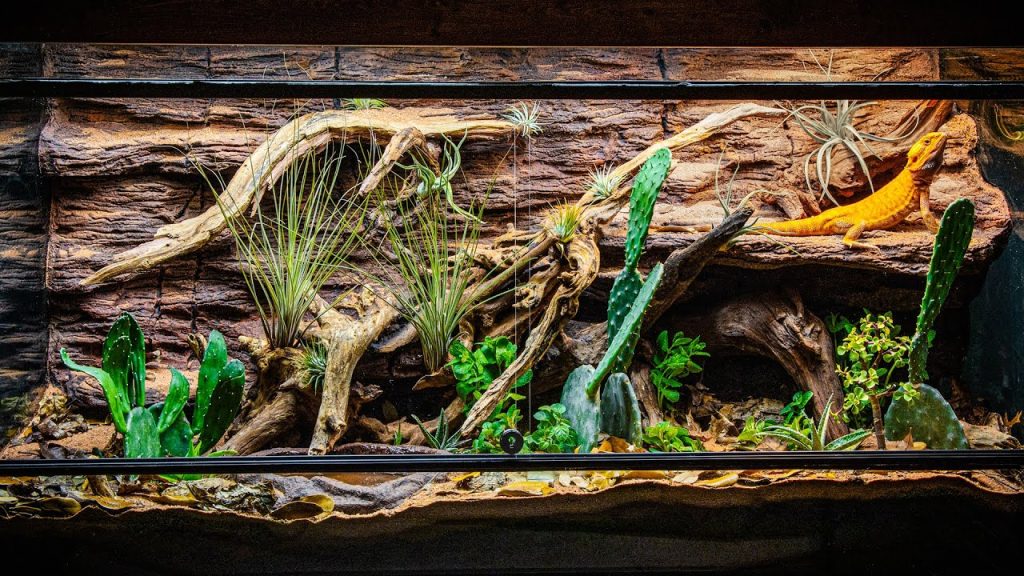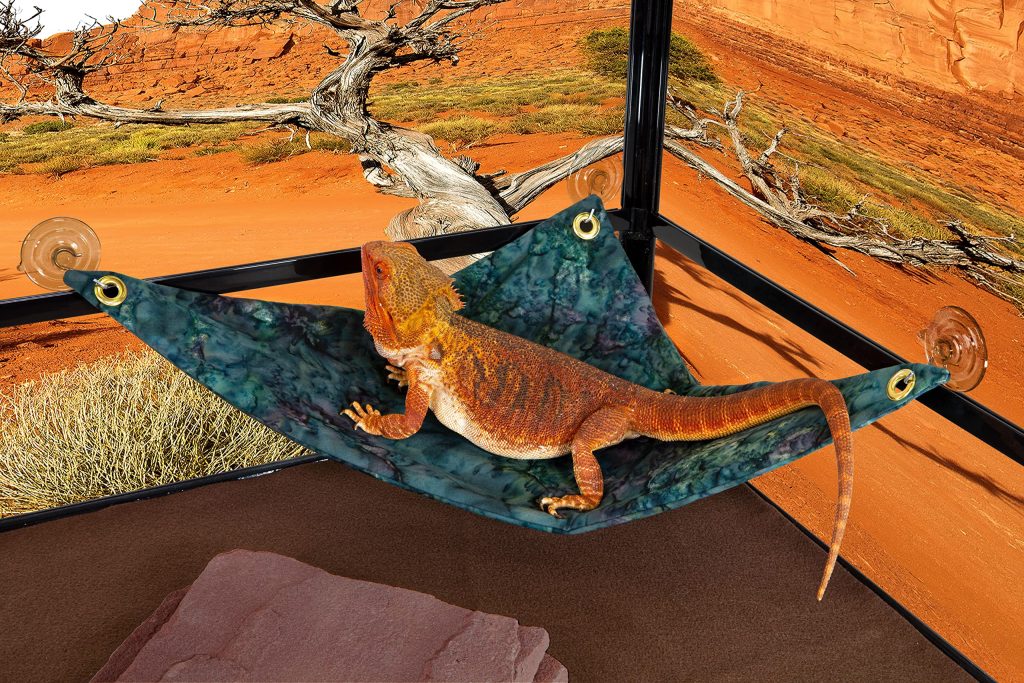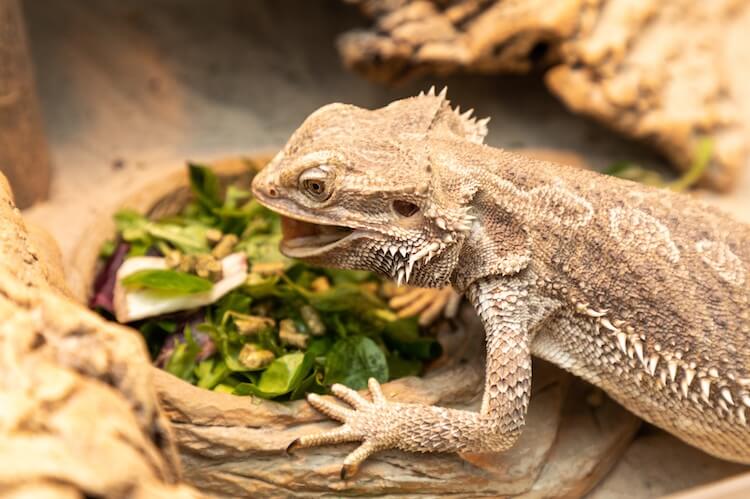One of the greatest lizard pets ever is typically thought to be the central or inland bearded dragon. They are noted for being vigilant, resilient, and gentle.
Fascinating behaviors are also displayed by bearded dragons, such as “arm waving,” in which a female may elevate her front leg into the air and “wave” it in a subservient manner.
It is unusual for tame captives to extend their spiky “beard,” from whence the lizard derives its popular name; dragons usually do this when startled.
With the help of the popular beardies, reptile ownership has gone from being highly specialized to being as mainstream as raising hamsters.
Many bearded dragon owners like seeing their lizards, whether during a shitstorm when chasing insects or just engaging with each other.
Because they are entertaining to watch, simple to manage, and simple to keep, bearded dragons are very popular. Here is a comprehensive bearded dragon care sheet and guide for you, before you get a new dragon,
Typical Bearded Dragon Behavior and Appearance

Happy bearded dragons make good pets, and knowing how to read their body language makes it simple for pet owners to determine how they are feeling.
Although beardies exhibit some behaviors when among their owners, others are only displayed when around other dragons.
They exhibit a variety of social, territorial, and wellness activities, some of which show strong emotion. Visual signals, such as an expanded beard, head bobbing, and arm waving, can be used to understand the bearded dragon’s behavior.
Ultimate Bearded Dragon Care Guide for Beginners: Everything You Need
Bearded Dragon Habitat
Beardies grouping is frequently discussed yet hotly contested on some sites. Two bearded dragons require a pretty large cage, to begin with, and the larger the enclosure the better if you want to maintain more than one in a glass tank so they may each have a spot to “call their own.”
Make sure the female bearded dragon is healthy and in good shape before housing her with a male bearded dragon till she is around two years old. Younger, smaller, or unwell dragons are more prone to experience issues, such as egg binding.
Bearded dragon environment
Bearded dragons are commonly found in deserts, heathlands, tropical savannahs, coastal dunes, and woods. They frequently can be found enjoying the sun on stones, fence posts, branches, or tree stumps. While lapping up some sun, they may observe predators, prey, and partners from this vantage point.
Size of the Terrarium
Bearded dragon needs the perfect environment in which to thrive is part of care for bearded dragon. You’ll need a terrarium with a screen cover that has a minimum volume of 40 gallons (151 L), which is 36 inches (91 cm) after your bearded dragon is fully grown.
If available, a 48″ x 24″ (122 x 61 cm) enclosure would provide your bearded dragon sufficient area to move about and get some exercise without you having to sometimes let them out to roam the home.
Bearded Dragon Care Guide
Bearded Dragon Supplies
The following materials must be on hand before you may bring your dragon home:
- Enclosure
- A UVB light
- Temperature gauge, thermometer, and heating element
- Basking rock or log
- Flooring: Substrate
- A few shallow utensils for meals and drink
- Tweezers and live feeder insects
- Sufficient room in your house
What Belongs in the Terrarium of a Bearded Dragon?

Make your bearded dragon feel more at home with the best material for your dragon tank right now. There are undoubtedly many possibilities, so if you start checking them up online, you can feel frustrated.
Size, material, and the location of the enclosure in your house are all things to think about when selecting the perfect enclosures for your bearded dragon tank setup.
Enclosure- In particular during those first few weeks of giving your bearded dragon home when she is adapting to whole new surroundings, selecting the right size tank for your bearded dragon makes her feel secure and less agitated. Glass surfing, which is frequently brought on by dragons feeling too confining, is also avoided by a good size tank.
Substrate- Lay a reptile carpet or tile on the cool side of the tank that houses your bearded dragon. For the dragons who are smaller, a carpet is a preferable option. Use reptile carpet for your dragons no longer than 8 inches.
Because these guys are so little, it would be harmful to them if they were to unintentionally consume the bedding.
A UVB light
Because they release heat in addition to UVB rays, self-ballasted mercury vapor UVB lamps are frequently recommended by veterinarians.
In order to guarantee the highest quality light and keep your bearded dragon warm, it is advisable to change the UVB bulb every six months. Healthy bearded dragons are ectotherms, meaning they need heat.
Therefore, in order to feel comfortable, they will require both a steady supply of heat and a chilly location. They need a thermal gradient in their terrariums.
Humidity- Because it resembles the humidity levels in their natural habitat, bearded dragons prefer environments with humidity levels between 35 and 40%.
This is frequently simple to accomplish by simply allowing proper ventilation (for instance, your glass tank screen lid), positioning the water dish away from the basking area, and avoiding over-misting your dragon’s tank.
Thermometer
It’s crucial to have an accurate thermometer on hand to make sure your dragon is receiving the right temperatures at all times of the day or night.
You could put a couple of electronic thermometers at the other end of the bearded dragon’s tank, or you could swiftly scan various parts of the tank with a temperature gun.
A bearded dragon’s habitat should really be between 75- and 85 degrees Fahrenheit on the chilly side of the tank and between 95- and 100 degrees Fahrenheit just on the side where it will be sunbathing.
The ideal night temperature is between 65- and 75 degrees Fahrenheit.
Hygrometer
A hygrometer is useful for monitoring the humidity levels in your dragon’s tank.
Screen
You could come across various terrariums with screens made of wire when looking for one. These pose a serious threat to bearded dragons.
Beardies can suffer injuries in screen cages in addition to the apparent temperature issue. Of course, glass terrariums with a screening lid are a separate thing because it’s unlikely that the bearded dragon will be able to access the lid. We do not advise utilizing a terrarium with a screen wall.
Finding Decor for Reptiles

Bearded dragons enjoy climbing, exploring, and burrowing. Decorate the pet’s habitat with amusing items to encourage these organic motions.
The animal’s native surroundings in Australia are mimicked by the use of large flat boulders for sunbathing, tall grasses for protrusion, and fake tree branches for movement.
Hammock
Bearded dragons love relaxing in hammocks for long periods of time. Your bearded dragon will like it if you place one on the side of the tank across from the heating light.
Basking Log or Rock
Your bearded dragon will want a sizable surface to bask on underneath the heating light, such as a log or rock. The best object for this is a log or rock.
Where To Place the Setup at Home?
Keep Your Dragon Out of the Sun’s Direct Rays
You risk losing your bearded dragon if you do this. Despite being good for them in the wild, sunshine rapidly turns harmful in a household setting. Particularly if the terrarium is made of glass, the sun’s heat can quickly become trapped within, raising the temperature to a point where your dragon’s life is in danger.
Make Sure the Tank is Simple to Reach
It’s ideal to make sure you can access the tank easily since you will need to clean it, take your dragon outside for fun and baths, and show it plenty of affection.
Keep Loud Noises Out of the Cage
Your dragons often become quite agitated by loud noises. Try to keep your dragon out in the vicinity of any loud devices you often use, such as a large-screen TV, an electric guitar, or a side of your home where you can hear continuous traffic.
Bearded Dragon Diet: Complete Guide for Beginners

The young, bearded dragons eat anything. They consume an equal number of plants and insects, which allows them to meet all of their nutritional requirements as they develop.
The more herbivorous they get as they age and consume fewer insects. About 90% of the food consumed by adult bearded dragons is plant materials, including bearded dragon pellets. The optimal bearded dragon’s diet care consists of:
Insects
You can give feed your dragon gut-loaded insects once each day, such as crickets. Whenever a strategic element, such as calcium or other minerals, is provided to an insect to boost its calorific quality before being given to a reptile, the insect has been “gut loaded.” You can feed your pet mealworms, super worms, and waxworms, but only at modest doses.
Fruits and Vegetables
Beardies consume a lot of dark, leafy greens, carrots, squash, and peas, all of which may be provided regularly. You should feed your bearded dragon fruits like melon, berries, and citrus once a week.
Within a few hours, take out any food that they haven’t eaten to prevent it from going bad.
Water
Although fruits and vegetables provide the majority of the moisture needed by the dragons, it’s also vital to provide them with access to water.
Always keep a water bowl in your dragon’s cage, but pay attention to whether it gets used. A few dragons would rather soak in their water dish.
Beardies usually urinate or deposit particles in their water bowls, so you should change it frequently. Eliminate any deceased insects from the dish as well after each feeding.
Spraying a mist of liquid into the cage once or twice a day should be enough if your dragon refuses to drink from the water dish.
It won’t just keep your pet hydrated; it will also make him think of rainfall or the dew in the Australian outback in the early morning.
Suggestions for Feeding Your Juvenile Beardies

Feed your infant for ten to fifteen minutes each time, 3 times each day. After this point, don’t keep any unattended bugs in the cage. Baby dragons may eat more insects than adults since they need to grow.
Some infants consume up to 60 bugs each day. Vegetables may be safely left in the cage for your baby to eat whenever she wants. Don’t feed your infant in a tank with loose substrate since they can consume it by mistake.
Food That is Toxic for Pet-bearded Dragon
Foods high in oxalates are toxic for bearded dragons and should be avoided. The hazardous substances, potentially deadly microbes, or inadequate intake of other vitamins and minerals make other dietary products risky.
A few of the toxic foods for bearded dragons are listed below-
1. Bearded dragons shouldn’t be fed onions, either raw or cooked. They are also excessively acidic for the delicate digestive system of your dragon.
2. Due to their high levels of phosphorus and acidity, mushrooms can be hazardous to bearded dragons when consumed.
3. Avocados may be fatal to bearded dragons and are harmful to them. They also have oxalic acid in them.
4. Eggplants are far too acidic for a bearded dragon, whether they are raw or cooked. So when it comes to this fruit, it’s best to be cautious than sorry. A surplus could be dangerous.
5. It doesn’t take much of the poisons found in fireflies for bearded dragons to die. Never allow them to consume fireflies.
6. Despite their apparent safety, many caterpillars and butterflies can be fatal to bearded dragons. The issue is that they consume a wide variety of plants throughout the day. Many of these plants contain poisons that can be extremely harmful to bearded dragons.
Bearded Dragon Health: Care Tips
Bearded dragons are quite hardy creatures if they are given sufficient care, a good diet, and the right environment. Adenovirus infection, infected stomatitis (often known as “mouth rot”), parasites, parasitic infections, and metabolic bone disorders are among the major health issues that affect bearded dragon pets.
A common bearded dragon needs to see a vet four different times. Within the first week of ownership, new bearded dragon health should be observed.
To ensure proper beardie care and that they remain in top condition, regular vet appointments should always be scheduled.
To check for parasites and to assess overall health, yearly checkups are required. Prior to brumation, a parasite check is also necessary.
And if your bearded dragon is sick and you have any doubts about its health, immediately consult a veterinarian.
Why Bearded Dragons Make Good Pets
Due to their easygoing demeanor and strong bodies, bearded dragons make good pets. They are entertaining to observe since they love to climb, aren’t weak, are fast to adapt to new living conditions and enjoy being near people.
Bearded dragons live alone, so keep that in mind while selecting the ideal pet. There’s no need to obtain a scaly partner because you’ll wind up being the dragon’s greatest buddy and keep the pet happy.
Buy a Bearded Dragon
To purchase the right bearded dragon, you need first choose a healthy dragon that fits your demands as a pet owner and your budget and is easy to care for.
The pet is then available for purchase through a registered breeder, in a pet store, or at a reptile exhibit. Although average bearded dragon babies are adorable to look at, they are vulnerable and more likely to get sick.
Additionally, some baby beardies may lose their appetite and require force-feeding in order to survive. A fully developed or almost fully grown dragon will be healthy and simple to care for as a pet.
Cost
Typically, the price of a classic baby or young juvenile bearded dragon ranges from $30 to $60. Adults often cost $100 or less. There are a good variety of distinct bearded dragon morphs available nowadays.
Depending on the beardie’s appearance and genetics, prices may change. The price of the specimen increases with the rarity of the morph and the saturation of the colors. Some adult bearded dragons can go upwards of $1000.
Conclusion
With the right care, healthy bearded dragons may live up to ten years. Your dragon’s ability to live a long and healthy life depends greatly on the terrarium.
You can provide your reptile a place to live where she can grow now that you are aware of the fundamentals of setting up the finest bearded dragon tank, their diet, and the right approach to handling them. I hope you found this post about the bearded dragon care guide and sheet useful.
FAQ’s
Is a bearded dragon easy to take care of?
If given the proper care and medical attention, bearded dragons may make wonderful, fascinating, simple pets. The lifetime of a bearded dragon is 8 to 10 years on normal, however, the oldest one ever found was 18 years old. They normally don’t bite and are gentle and simple to handle.
Is a bearded dragon good for beginners?
Because they make excellent first pets, bearded dragons are quite well-liked and widespread among reptile keepers. Being able to care for a unique pet reptile appeals to me, and many herp breeders and dealers who like seeking out uncommon morphs feel the same way.
Is a bearded dragon a good pet?
Children and adults who like to travel would love having a bearded dragon as a pet. They are extremely receptive to their owners and are extremely gregarious, amiable, energetic, inquisitive, docile, and gentle creatures. Bearded dragons tend to have a strong, healthy, diverse diet, and they are durable creatures.
How many different types of bearded dragon species are there?
In the wild, there really are eight distinct species of bearded dragons. Only four of the eight species are maintained as pets, with the Pogona vitticeps being the most popular.
How Should I Care for a Bearded Dragon?
While seated, gently handle your dragon. They won’t hit the ground if they happen to jump or flee away. When it’s time to play with your dragon, consider unwinding on a plush surface like a couch or bed. Pet the animal in the direction that the scales are growing after that.
Hugues Beaufrere is the Exoticpetia’s senior writer and reptile expert. He has been fascinated by reptiles and monkeys since he was a kid and had years of experience in herpetology and primatology. He has cared for various kinds of Monkeys, Lizards and Reptiles and loves to share his knowledge and passion with others.


